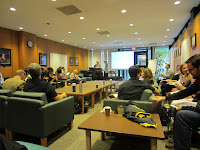 |
| Proxy Agency |
 |
| Out to pasture |
 |
| Allen Lambert Galleria |
 |
| a conditioned urban alley |
As is my wont whenever I'm on a short visit to a new city, I booked in advance a guided architectural walk, this time, the Art and Performance Tour in the Entertainment District of Toronto. And as is my usual good fortune, I managed to meet up with a knowledgeable and enthusiastic volunteer architecture buff, and as we happened to be the only two visitors for the tour on that Saturday morning, we got all his attention. Of the many buildings we stopped by, two stood out - The Art Gallery of Ontario (AGO) and the nearby Sharp Center for Design. You can see the two buildings in a short video by an architecture critic, Christopher Hume, at the Toronto Star.
 |
| A disappearing act |
 |
| Exuberant curve |
 |
| Bent wood armature |
 |
| Bent wood spiral staircase |
 |
| Gratitude for a leg up |
 |
| Tabletop |
 |
| The Crystal |
 |
| hard to be missed |
Canada seems to have sidestepped the banking crisis (due to the conservative lending practice of their venerable banking institutions, according to our guide), and bucked the global trend of economic recession. According to an article in the Toronto Star, Toronto has been experiencing unprecedented growth in construction, especially in mixed-use, commercial/residential towers, and there were more towers (132) under construction last year in Toronto than any other city on earth, with even more this year. My overall impression of the architectural scene in Toronto, at least in the downtown area, is that they have a hodgepodge of old and new buildings but do not have a coherent story to tell or a prominent skyline to speak of. With due respect, Toronto, though in close geographic and cultural proximity to New York State, is no New York City. No wonder Claudine bemoaned the loss of her beloved NYC when she first moved there.
We had a couple of curious cultural experiences passing through Toronto Pearson International Airport. On the way in, we were sent to the Immigration area because of the suspicion that Kirk might be engaging in some covert business consultation as he was to be compensated for giving a "colloquium" ("what is that?", the Immigration Officer asked) at York University. On the way out, I had an unpleasant exchange with a Canadian Airline agent when I asked her how to get to the Customs area. (For flights to the U.S. one has to clear US Customs in Toronto.) She answered me with such thinly veiled contempt that it took my breath away. I'm not sure whether her sense of superiority was directed to me as a US Citizen or as a person of Asian descent.